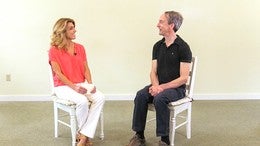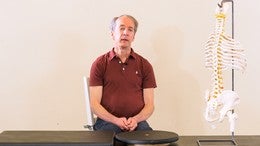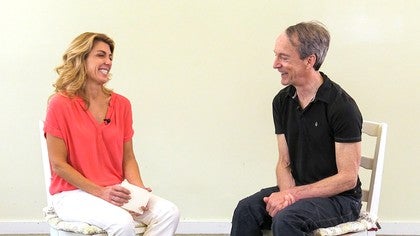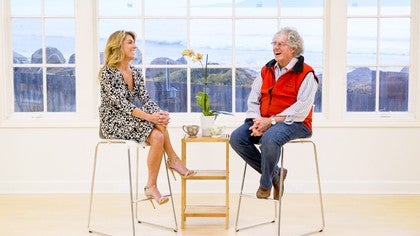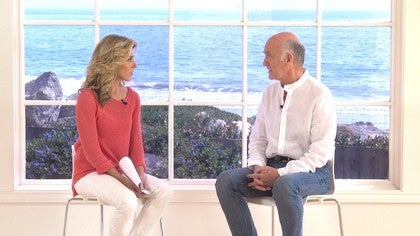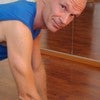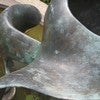Discussion #2230
Jean-Claude West - Abbreviated
Description
If you are interested in learning more about Jean-Claude, watch his full, in-depth discussion. It takes you through his whole life up till present time.
About This Video
Transcript
Read Full Transcript
Jean-Claude West is a teacher of teachers. He's a movement analyst and technician with rich hands on skills and an even richer background. In addition to receiving his masters in motor control, Jean-Claude furthered his knowledge through his own deep explorations, observations and experience in the school of life. His collaborated with important mentors and colleagues from so many fields that he defies being identified with any single modality or being placed in a box and array of leaders from the [inaudible] dance bodywork and fitness communities refer to John Claude and his work with deep appreciation for his insights and expertise regarding movement and physical embodiment, not to mention his various invention supporting his work in this regard. For many years, young cloud West has been out there quietly working in the trenches with us and for us sharing his own evolutionary process and development. Now, it is my great honor to invite him forward today in conversation both to acknowledge his service and alert the larger community to his contributions. Welcome Sean Cloud West. Thank you.
I would like to know how you transitioned from being a student of movement to becoming this teacher of movement. But I don't want to skip any big events in between. So can you just start to walk us along the line that, you know, eventually led to [inaudible] and so many other things?
And he says, here, come and join me in the brochures. You know, why you're in this hiatus. So I did. And, um, you know, in the Berkshire's, uh, that, that's a big hub, big artists colony, and it's where Jake is Pello is where Ted Shawn read this, say Dennis started modern dance, the pioneering of it all, a lot of theater, a lot of arts going on. And, um, so when I was there, uh, I still wanted to pursue my martial arts and, um, but I found it in this town of Great Barrington and there was this dance school that, uh, had, uh, an advertisement for Tai Chi. And I went there to see, uh, uh, about it and, uh, uh, asked the woman who ran the dance school, whether the teacher was still there and she has no, there's, there's, he's gone. That was not an old advertisement. I went, oh, I was disappointed. And she says, well, you're welcome to take this a adult modern dance class. And Cause I've taken a ballet class actually when I was an Undergrad. And so I said, well, you know, I knew the a, it could at least keep me flexible and, and uh, keep me tuned up for the martial arts. Uh, cause I had already kind of put my time in on it. I just wanted to stay fit. So I took the class and, and uh, at that point, you know, with my martial arts, I had already, um, finessed a straddle, split up, had very flexible hits and, and, uh, I can pin my leg by my ear and, and uh, I can actually kick almost like a six o'clock. Wow. Sidekick.
You know, I had that kick. Yeah, sidekick six o'clock. And, uh, so, uh, you know, when she saw that, saw my strength and my flexibility, uh, she really, uh, kind of pulled me, she wanted to, uh, definitely get me into her, um, her performing group that she had in residence within her school. Modern dance. Correct, exactly. I also became a scholarship student at, at a ballet school there and uh, and the Berkshire is, and also Jacob Sapelo was there, so I took classes there. But along with that, uh, um, I, uh, audition to, well first I took this adult modern class outside that school and, uh, it was actually a class, the teacher was my, uh, future wife and, uh, she asked me to, uh, be a, um, performer and a piece that she was auditioning for a, uh, a state grant. And, uh, that's how we met.
So generally people don't know about Pele's, but did at Jacob's pillow, I'm guessing they might. Did you ever hear about it? Never heard of, no.
And so this is the time I got my first exposure to Galatia.
And so what was your first impression of [inaudible] then? You talked about the space, but what did I, yeah, so I walk in and I see the equipment, you know, I, I, I'd done some weight training and used that. I used the universal machines, kind of this multipurpose, uh, um, apparatus. You can train every muscle in your body, whatever it is, one piece. And, and, uh, so when I saw the plots and I saw springs, you know, what is, what is that gonna do to you? You know, that's not enough resistance to create strength. Well not the case. You know, this a teacher went after me, you know, and you know, I realized that, uh, my core wasn't as strong as I thought it was cause I was, you know, as strict from the court within the context of my martial arts. But I'm not within the context of pilates where a pitch is much more demand on them. That's spinal support. And um, and I like the idea that it, uh, it really, I felt more integration as I was doing it. Like when I go on the reformer and I started to use a leg press work, but not to think of leg pressing to develop stronger quads but feel integrated through the leg press work. So it wasn't about how many springs I had on it, but how I implemented the, uh, the leverage. Okay, keep going.
Tell me why this is great. So now you've met Marybelle and at some point, Brian. Yeah. And so in a way I didn't, I didn't meet very Bowen cause she was the owner and she, you know, is, is a, a union analyst. So, and she had our practice both in Connecticut, in New York, and then up in Massachusetts. She wasn't there at the Times. I was there most of the time, so I didn't really meet her, uh, when I was, uh, studying at Urine Joan and, but also, uh, as I said, I was pursuing a mass, some master courses in biomechanics and was doing motion analysts doing forced plate work, um, more can these courses, static dynamic courses in the engineering program. But it was pretty sterile. I didn't, it wasn't, I was just doing it to kind of, you know, as my wife is pursuing or my future wife was pursuing her MFA at Smith College. Um, but during that time, uh, there was probably one of the first dance medicine symposiums.
They were at Umass Amaris where they brought in this orthopedists, uh, from Boston named my Kaylee, who is one of the Dance Orthopedics Pioneers, Ruth Solomon, who's one of the big dance kinesiologists along with a couple of other speakers. And along with that was Martha Myers, uh, who was the, uh, um, she was the head of the, uh, uh, American dance festival. And also at the head of the Dance Department at Connecticut College. Okay. And, uh, somehow I got to meet with her and we had lunch and she was wondering my, about my interest in, uh, science, the movement and how I was putting out the dance. And then she invited me to come down to the, uh, Connecticut College to teach a, a class with talking about how you can, uh, work with some of the, uh, constructs of physics in dance, you know, either through partnering or technique. So I went down and kind of like, um, winged it and taught a class there. But along with that, I met a modern dance teacher, uh, named Shirley Houlihan, who is a, uh, a company member of large Lubavitch. And um, she says, oh, so you have you studied plots before? And I said, well, I am doing a little plots. It's this gym called your own gym. She's, well, you know, you should really go down to New York.
And there's this teacher that I work with who really transformed me and it's just look, and she hyper extended her knees and her knees pointed inward. She just, I learned not to do that through this teacher. And I said, wow, who was that? And she says, it was this woman named Cathy Grant. And, um, so at this time I was already, um, uh, put my admissions in for a Columbia Teachers College and this program called motor control. And I got in and so I was gonna moving down to Manhattan. So, um, Mary Bowen, um, said that she would write a letter for me for, to, uh, be introduced to Kathy grandkids. Catch grant. It was quite difficult intuitively. Yeah. You had to write a letter of introduction. So, sorry, just for timeline, we're now in 84. Five, yeah. 84, 85. Yeah. And Kathy would have been at Bendel's at that time. Yeah, she was, I don't know.
You had, you couldn't just go in and pay money. No, no. You, you, you had to pay your dues because I, yeah, she, she had all the, uh, who's, who's, you know, uh, both in the dance world and also in the, uh, the social world. And, um, so Mary writes a letter saying it's a letter of recommendation, letter recommendation. Yeah. And so it took me about maybe six weeks to get into and then I finally arrive. And, um, there's, I go up to Bendel's and uh, you know, then I don't, I don't, I'm sure the story has been told many times, but you know, it was a floor. You got off of it. It was the, um, hairstyles and, and you had to walk down this hallway and to the right with the restaurants and to the left was this exercise room. You walk in, it's this low ceiling, two in a square foot area. Wow. And there's Kathy grant right at the entry point, uh, with your equipment.
And it was just a, it's a full studio. It's a full studio. You know, it had a Cadillac to reformers and uh, a ladder barrel and a small barrel and a couple of mats. But you know, she had anywhere between three to five people working at a time and that small space, but they all respected their spaces. And, um, so the first thing that she noticed with my head alignment, my head was a little off and my sternal notch here. And so I had to go through this trial of, uh, lying supine on my back and putting a ping pong ball on the notch and my sternum and just bringing my head up symmetrically. And, uh, I had to do that for several weeks, you know, just that, you know, cause she wanted to see me do that symmetrically before she would, uh, broadened my repertory. The first thing that comes to mind is it reminds me of grade 300 kicks that you are. But the second thing and maybe more outstanding is what would make you stay. That's a good, good point. Um, what I mean, a ping pong ball on your right. Right. I know she's, what would make you stay at that point? Uh, I think it was more, cause I was scanning and I was looking around what other people were doing and they were doing these crazy tasks. I mean, it's hard to describe what the magic circle or being inverted and breathing.
And they were all in their own little ivory towers, you know, you know, they're not looking around. They were very attentive to what they were doing. And I think that was the intrigue. Who, who are you working out next to? You know, who would the types of people in there? You said? I think there were dancers with some of the major modern dance companies in New York City ballet and yeah, and, but again, there are a lot of um, people in the New York social world that I didn't know, but they were quite the who, the suse. So that explains a little bit of why you couldn't just go into, right, right, exactly. I mean she had no problem with market. What, what, what was the session costs at that time? $13 and 80 cents and 80 cents.
Yeah, it was a tax, some of the tax amount. Was that a lot, did it seem like a lot or no, I would seem relatively, yeah, I think he knows it was a stretch for my mind. My pocket for sure. And how often would you go? I think I was going maybe twice a week. Yeah. When I went down to New York City to live there to pursue my degree at uh, and motor control. Uh, when my wife was teaching at the small school called, uh, Simon's rock college in Great Barrington. Uh, one of the people who was the head of the dance department there who was from Tennessee, um, had some, um, friends that started this one-on-one fitness center right when new personal training was starting on the upper east side. And they were looking for people trained to take on their clients and their names were giddy and Patty Cohen and the gym was called Poly Chen. And it was on the upper east side on 75th, between first and York.
And when I went there, it was this beautiful gem. It had state of the art equipment, a very art deco in interior design. And a, the clientele was, you know, Broadway people, investment bankers, cause it was a pretty high budgeted, uh, fee for, for working there. So we would rent the space, they would supply the clientele and then we'd also bring in our own clientele. There.
And then I also took measurements off of a Cathy's equipment and I built, uh, two sets of my own equipment, you know, two reformers, a trap table, high trap table, high low table, uh, tall chair, small chair, a ladder, barrel, small barrel. But along with that I also bought, um, for a refurbished to acknowledge equipment. Equipments I have is kind of married to two my days of gym. I had thought they had a lot of value [inaudible] and I really wanted to bring them with me.
Okay.
And plus I didn't really know about the existence of current contract and current concepts at the time. And um, so I got sample springs from Kathy there cause I think there was one company in Connecticut called Newcomb Spring Company bought, made the springs for Romana and some of the other plot of Corolla studio. Um, but I decided not to go that route and I found this guy named, um, Ernie Suckler who had this spring company called ABC springs. And I gave him the samples and it wild. I mean I went into his shop and it was total chaos. He's giant. You realize what, how large these machines are that make the springs but they're here. No, I gave him the sample of springs.
He got his calpers out and measured the length and what it was, tomato, blah, blah, blah. So he, uh, he made springs for me. Some of my equipment was kind of customed like especially my trap table. I made it, it's hard to explain, but it had extensions beyond the, the, the rectangular cage you have above.
So I learned how to work with power tools and routers and table sols. I knew I didn't know how to create a joint, a solid joint.
Which made rehab equipment and I got newsletters and this one newsletter arrived and I never forget, 1988 and there was this prototype, seated and standing, um, [inaudible] machine that worked on the rotary stabilization at the knee and the hip and just stand on it. You stand on it or you sit and you rotate the, the, uh, the desk. And I went, wow. I said, it's like a lazy Susan. I can do that. So that's when I started to apply at lazy susans on the sliding thing. So I had a sliding, turning out machine. Uh, and I used to, Lacey's isn't a lot for the standing leg in the dance context is always working on that externally rotated hip position and a few other products now on the piles world. That right. Y'all use that right yet her name all over him. So we're right, right. Yeah. So during that time I realized that, you know, using a lazy Susan in order to be Mesh or synchronize your mechanical axis of your leg to the Makino axis as the Lazy Susan, you know, the center point of the Lazy Susan, a true pivot point, any beyond anything beyond the center point of the Lazy Susan Christen Arc, that's how the hip works. You know, you really want to be on the center point of the Lazy Susan, but in order to do that, you'd have large lazy susans to support the foot. Therefore your feet would be too far apart. So I had to figure out a wave, well, how can I do that?
So I created a device called a functional footprint along with my colleague Katie Keller. Just a whole nother story. Um, which uh, UFC three inch lazy susans. And it was a shape of a foot, but the lazy Susan was right at the pivot point of where the mechanical wax. So the leg is, which is right above the a cuboid navicular, you know? Right, right. Where the medial arch is.
Those who evolved in the, uh, the winter of 92. Wow. I'll never forget one day. It was in 1990. Um, at this time I was working a lot with professional pans community and um, I worked a lot with the companies Lard Lubovitch and I had a, there was this company being formed called the white oak project. It was a cofounded both by Mark Morrison McCale version of call. And uh, they had their first Herschel process in the spring of 1990. And I get this phone call from one of the, uh, one of my friends and members of the company and he says, you got to come down, you know, um, we to have somebody to work on our bodies. And along with, uh, uh, Nisha, Nisha because, uh, at the time, uh, when Nisha, uh, started this company, uh, his physical therapists who know, cause he's very, um, respects, uh, you know, that therapy is needed for all the answers.
Cause they were constantly tweaking the body. And, but, uh, the therapist for the American ballet theater at the time was locked up, you know, with American ballet theater. So he couldn't come down. And not that I was gonna substitute for him, but you know, they wanted to bring balance, somebody who can work, uh, with their bodies to keep their bodies intact. Bring down where was white oak? A white oak was actually going back down to where I grew up in Jacksonville, Florida, where I actually was in St Mary's Jerick, Georgia, which is like an hour 50 minutes north of Jackson. You had to lay in it, you had to land at Jackson Hill to get the white oak. So I went, oh my God. And at this time I, you know, I didn't work a lot with my hands. I worked a lot with queuing on the equipment, queuing motor control, but um, you know, wasn't working heavily with my hands, you know, as far as intention.
So I really wanted to have equipment. I went, oh my God, what am I going to do? So, um, I am not going to take the whole studio. Right. I can't take the studio. And so I, I had this, a very good friend of mine, Daniel Peters, who was a dancer along with being this incredible carpenter. So I, um, kind of conceptualizes, um, four and one pieces of equipment, which is a reformer, a, a trap table, a partial trap table, a chair and a mat. Well, what is this called? It's, well, you know, it's funny cause I saw one of my clients said, you got to come up with the name, you know? Yeah. So I don't know what my calling is. Well, you've got to have your name on it, you know, I said, well, how about your initials? And I said, well, okay, JC, what year were you born? I said 56. Oh, we'll call it the GC 5,600. So that was the name. She said her soc euro was born. That's fantastic. Where is that?
So the JC 5,000 is taken of different journeys, but eventually, uh, I had, um, current concepts make it apparent and, uh, I don't know how many you made, but I don't know what the numbers are, but there was quite a few, uh, especially, uh, several of my students.
Yeah, sure. Um, I've heard Mary Bowen say she's worked with you for seven years and I understand that to mean you were teaching her, right? Yeah. She came down and say, yeah, so or client or whatever you want to call it. Did you, did you study? Who else did you know? I'll just throw out a few names. Um, Bruce King.
And it really was much about that, you know, he didn't want to see a lot of muscular strain as you performed the repertory and you know, he, he was in it, you know, all, he was also a modern dancer at the real pioneering days with Hanya home. And you also danced with this, um, company of Eve gentry's. Um, and uh, so when I studied with Bruce and my wife and I were going out to, uh, Santa Fe in 89, I think that's what it was. He says, oh wow. You know, um, if you go out to Santa Fe, you should really check out, uh, this police teacher and him Eve gentry. Had you heard of her before? Never. You know, I don't think the name people would it hurt her? It hurt? No, cause no, she, uh, in a way kind of isolate herself being, being at, being out there. She was out by herself. And, um, along with Michelle Larson who was really the productivity, you know, she stayed with her for years and I, so we went out there and I got the meaty youth and, um, uh, we had an exchange for over a weekend. Um, she worked on me and I actually worked on her and at this point she was 80, 81 years old. And, um, she was just an incredibly giving person. She brought out our movie projectors, showed me movies of her working with Joe [inaudible]
Um, but why did you film it if you didn't do it all? Film, anything? Yeah, I, this is actually starting off,
And I brought eve along with me and at the time I'd been working with mark, so I had a relationship with him. And so I brought her backstage and, uh, introduced to the mark and she introduced herself. She says, do you know that I was one of the original dancers with Hanya Holm? Mark's reply says, wow, you must be ancient.
If he's having fun with you. So I'm being efficient. But um, anyway, so that was a fun moment. So then when we, uh, during the time she stayed with me, we had to go, my wife and I had to go to her wedding and I left he there and not knowing, Eve invited Bruce Down to my studio and Bruce King and they played around with my equipment for hours. So when I came home, I mean he was comatosed too. She just burnt herself out because she was having a heyday comparing with Bruce of what they were doing, you know, within the Plata thing.
What about Ron Fletcher?
Um, so a couple of summers ago I went filming a bunch of interviews for that, the Pele's legacy project and your name kept coming up over and over again. And then, um, and it always has but not so much as it did in that one consolidated time for me. And, um, so there are other names that I don't really know the full story or if there is even a story, but there are other names. I'm just curious if you could kind of help me put the pieces in the puzzle that, that you've influenced or you know, like for example, rail as Sakowitz writes in the forward, uh, I don't remember the exact story, but I know your name is in that story, so
However little he might've worked with her one to one, but, right. Ken Andelman do well. Yeah. It, you don't care. Again, sir,
My sister's gone huge from two people to that. Yeah. Did you, did you go, he always said, because he wanted to see the JC for 600, so I brought that out there. Okay. That's what she did produce. He did. Yeah. And why don't we know,
And so we ended up doing that and then Ken and I one time took a, yeah, he got it. By the way. That is their number. No, no, I know exactly.
Were you aware of what took place when the trial began? I mean, were you, were you at the trial at all? No. No, I didn't have any to do with it. Nothing. Um, did it change anything from your perspective now, you know, Kathy grant had and, um, Mary Bowen were in support of you opening up the studio and now this is going on. Did it change your perspective or did, did you feel anything changed in the community because of that? Or did you not notice it during that time?
But it really pinpoints some of the, uh, um, intrinsic asymmetries. I mean the, uh, asymmetries. This, how the spine or the, uh, the chunkers between the spinal segments that the set joints operate and how they organized to create, um, movement demands.
The Teacher's Corner: Discussions
Comments
You need to be a subscriber to post a comment.
Please Log In or Create an Account to start your free trial.
